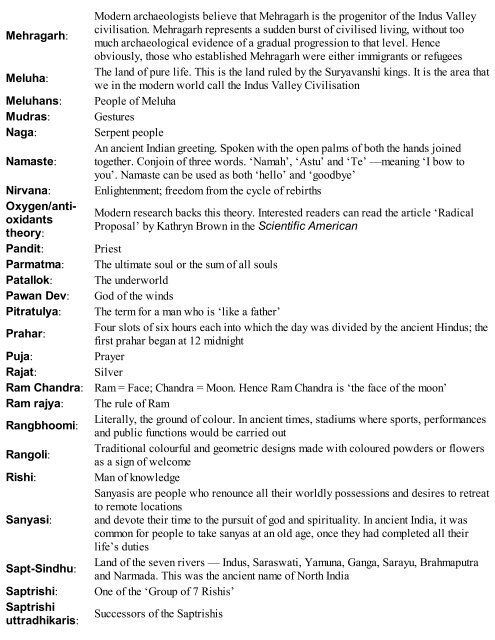the immortal of maluha
You also want an ePaper? Increase the reach of your titles
YUMPU automatically turns print PDFs into web optimized ePapers that Google loves.
Mehragarh:<br />
Meluha:<br />
Meluhans:<br />
Mudras:<br />
Naga:<br />
Namaste:<br />
Nirvana:<br />
Oxygen/antioxidants<br />
<strong>the</strong>ory:<br />
Pandit:<br />
Parmatma:<br />
Patallok:<br />
Pawan Dev:<br />
Pitratulya:<br />
Prahar:<br />
Puja:<br />
Rajat:<br />
Ram Chandra:<br />
Ram rajya:<br />
Rangbhoomi:<br />
Rangoli:<br />
Rishi:<br />
Sanyasi:<br />
Sapt-Sindhu:<br />
Saptrishi:<br />
Saptrishi<br />
uttradhikaris:<br />
Modern archaeologists believe that Mehragarh is <strong>the</strong> progenitor <strong>of</strong> <strong>the</strong> Indus Valley<br />
civilisation. Mehragarh represents a sudden burst <strong>of</strong> civilised living, without too<br />
much archaeological evidence <strong>of</strong> a gradual progression to that level. Hence<br />
obviously, those who established Mehragarh were ei<strong>the</strong>r immigrants or refugees<br />
The land <strong>of</strong> pure life. This is <strong>the</strong> land ruled by <strong>the</strong> Suryavanshi kings. It is <strong>the</strong> area that<br />
we in <strong>the</strong> modern world call <strong>the</strong> Indus Valley Civilisation<br />
People <strong>of</strong> Meluha<br />
Gestures<br />
Serpent people<br />
An ancient Indian greeting. Spoken with <strong>the</strong> open palms <strong>of</strong> both <strong>the</strong> hands joined<br />
toge<strong>the</strong>r. Conjoin <strong>of</strong> three words. ‘Namah’, ‘Astu’ and ‘Te’ —meaning ‘I bow to<br />
you’. Namaste can be used as both ‘hello’ and ‘goodbye’<br />
Enlightenment; freedom from <strong>the</strong> cycle <strong>of</strong> rebirths<br />
Modern research backs this <strong>the</strong>ory. Interested readers can read <strong>the</strong> article ‘Radical<br />
Proposal’ by Kathryn Brown in <strong>the</strong> Scientific American<br />
Priest<br />
The ultimate soul or <strong>the</strong> sum <strong>of</strong> all souls<br />
The underworld<br />
God <strong>of</strong> <strong>the</strong> winds<br />
The term for a man who is ‘like a fa<strong>the</strong>r’<br />
Four slots <strong>of</strong> six hours each into which <strong>the</strong> day was divided by <strong>the</strong> ancient Hindus; <strong>the</strong><br />
first prahar began at 12 midnight<br />
Prayer<br />
Silver<br />
Ram = Face; Chandra = Moon. Hence Ram Chandra is ‘<strong>the</strong> face <strong>of</strong> <strong>the</strong> moon’<br />
The rule <strong>of</strong> Ram<br />
Literally, <strong>the</strong> ground <strong>of</strong> colour. In ancient times, stadiums where sports, performances<br />
and public functions would be carried out<br />
Traditional colourful and geometric designs made with coloured powders or flowers<br />
as a sign <strong>of</strong> welcome<br />
Man <strong>of</strong> knowledge<br />
Sanyasis are people who renounce all <strong>the</strong>ir worldly possessions and desires to retreat<br />
to remote locations<br />
and devote <strong>the</strong>ir time to <strong>the</strong> pursuit <strong>of</strong> god and spirituality. In ancient India, it was<br />
common for people to take sanyas at an old age, once <strong>the</strong>y had completed all <strong>the</strong>ir<br />
life’s duties<br />
Land <strong>of</strong> <strong>the</strong> seven rivers — Indus, Saraswati, Yamuna, Ganga, Sarayu, Brahmaputra<br />
and Narmada. This was <strong>the</strong> ancient name <strong>of</strong> North India<br />
One <strong>of</strong> <strong>the</strong> ‘Group <strong>of</strong> 7 Rishis’<br />
Successors <strong>of</strong> <strong>the</strong> Saptrishis



